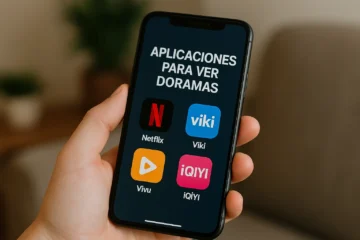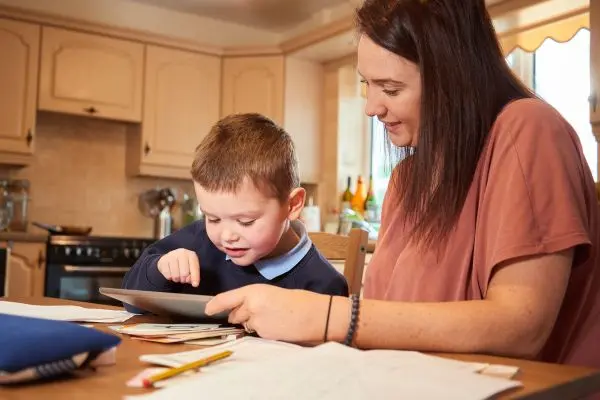Os melhores aplicativos de leitura para ensinar seu filho - Os 5 melhores gratuitos!
Anúncios
Descubra o melhores aplicativos de leitura para ensinar seu filho a ler em casa, com as melhores opções gratuitas.
Detalhes sobre os melhores aplicativos de leitura
Os aplicativos de leitura são ferramentas poderosas para apresentar a leitura às crianças pequenas de uma forma divertida, interativa e eficaz.
Esses aplicativos foram desenvolvidos para ajudar as crianças a aprender habilidades básicas de alfabetização, como fonética, reconhecimento de palavras e compreensão, por meio de atividades envolventes.
Muitos aplicativos de leitura oferecem versões gratuitas com as principais funcionalidades, enquanto outros oferecem opções premium para recursos avançados.
A maioria dos principais aplicativos de leitura pode ser baixada da Google Play Store ou da App Store, o que os torna facilmente acessíveis.
Em termos de segurança, os aplicativos de leitura de boa reputação geralmente incluem controles dos pais e são livres de anúncios, garantindo um ambiente de aprendizado seguro para as crianças.
A principal função desses aplicativos é aumentar a confiança das crianças na leitura, oferecendo ferramentas que são educativas e divertidas.
Os 5 melhores aplicativos de leitura para crianças
Aqui estão os cinco melhores aplicativos de leitura que ajudam a ensinar as crianças a ler em casa, cada um com recursos exclusivos para aprimorar o aprendizado.

Aplicativo 1: Duolingo ABC
O Duolingo ABC é um aplicativo de leitura gratuito desenvolvido para crianças de 3 a 7 anos, com foco no ensino de noções básicas de leitura por meio de exercícios interativos.
O aplicativo usa jogos, histórias curtas e traçado de letras para introduzir fonética, palavras à vista e reconhecimento de letras de uma forma divertida.
Cada lição é curta e simples, o que facilita o acompanhamento e a diversão das crianças sem que elas se sintam sobrecarregadas.
Os pais podem monitorar o progresso, e as crianças ganham recompensas à medida que completam os níveis, o que as mantém motivadas a continuar aprendendo.
O Duolingo ABC está disponível para Android e iOS e é totalmente gratuito para download e uso sem anúncios.
O currículo estruturado do aplicativo ajuda as crianças a avançarem naturalmente, tornando-o um dos melhores recursos gratuitos para os primeiros leitores.
Aplicativo 2: Khan Academy Kids
O Khan Academy Kids é um aplicativo educacional abrangente que inclui a leitura como parte de seu currículo para crianças de 2 a 8 anos.
Esse aplicativo oferece uma ampla gama de atividades, incluindo leitura de histórias, jogos de fonética e exercícios de reconhecimento de palavras.
A Khan Academy Kids é livre de anúncios e totalmente gratuita para uso, apoiada pela Khan Academy, uma organização sem fins lucrativos, tornando-a acessível a todos.
As crianças são guiadas por personagens animados que tornam o aprendizado divertido, e os pais podem acompanhar o progresso para ver as áreas em que seus filhos se destacam ou podem precisar de mais prática.
O aplicativo oferece conteúdo para download, para que as crianças possam continuar aprendendo off-line, o que o torna ideal para viagens ou áreas com acesso limitado à Internet.
Disponível para Android e iOS, a Khan Academy Kids é elogiada por seu conteúdo de alta qualidade, inclusivo e envolvente.
Aplicativo 3: ABCmouse
O ABCmouse é um aplicativo popular de leitura e aprendizado que abrange noções básicas de leitura e uma variedade de outros assuntos.
Voltado para crianças de 2 a 8 anos, o ABCmouse oferece histórias interativas, atividades de reconhecimento de letras e jogos de fonética.
O aplicativo oferece um currículo abrangente, orientando as crianças por meio de centenas de atividades que se adaptam à medida que elas progridem.
Embora o ABCmouse seja um aplicativo baseado em assinatura, ele oferece um período de teste gratuito, permitindo que os pais o experimentem antes de se comprometerem.
O ABCmouse pode ser acessado no Android, iOS e desktop, com conteúdo que pode ser acessado off-line após o download.
As lições estruturadas e os incentivos divertidos, como ingressos e recompensas, fazem dele uma opção envolvente para as crianças que estão aprendendo a ler.
Aplicativo 4: Starfall Learn to Read
O Starfall Learn to Read é um aplicativo focado especificamente na fonética e nas habilidades básicas de leitura, ideal para jovens aprendizes.
O aplicativo divide a leitura em etapas simples, começando com os sons das letras e progredindo para frases completas.
O Starfall usa animações, músicas e histórias interativas para ensinar cada conceito de uma forma fácil de entender e lembrar.
Esse aplicativo está disponível gratuitamente com conteúdo básico, mas uma assinatura de acesso total desbloqueia lições e atividades mais avançadas.
Os pais apreciam o design simples do Starfall, que permite que as crianças naveguem pelo aplicativo de forma independente.
Disponível para Android e iOS, o Starfall é um recurso confiável para a alfabetização precoce, tornando o aprendizado acessível e agradável.
Aplicativo 5: Jogos da PBS Kids
O PBS Kids Games inclui jogos educativos com forte ênfase na leitura, destinados a crianças de 3 a 8 anos.
O aplicativo apresenta personagens de programas populares da PBS Kids, o que torna o aprendizado divertido e relacionável para as crianças.
O PBS Kids Games oferece atividades de leitura como livros de histórias, jogos de fonética e exercícios de reconhecimento de palavras para ajudar a desenvolver habilidades de alfabetização.
Esse aplicativo é gratuito para download e uso, e adiciona regularmente novos jogos e atividades, mantendo o conteúdo atualizado e envolvente.
O PBS Kids Games está disponível para Android e iOS e oferece aprendizado seguro e sem anúncios, com conteúdo que reflete valores educacionais.
O que esperar (e não esperar) desses aplicativos de leitura
Os aplicativos de leitura oferecem uma série de recursos e benefícios, embora haja algumas limitações a serem consideradas.
O que esperar:
- Aprendizagem interativaOs aplicativos usam jogos, sons e recursos visuais para envolver as crianças em um aprendizado ativo.
- Desenvolvimento de fonética e vocabulárioOs aplicativos incluem exercícios que ensinam os sons das letras, palavras que podem ser vistas e vocabulário básico.
- Controle dos paisA maioria dos aplicativos oferece configurações para que os pais monitorem o progresso e estabeleçam limites de tempo.
- Acesso off-lineAlguns aplicativos permitem que o conteúdo seja baixado para uso off-line.
- Ambiente seguroOs aplicativos de leitura confiáveis são livres de anúncios e priorizam a segurança das crianças.
O que não esperar:
- Habilidades avançadas de alfabetizaçãoAplicativos: Normalmente, os aplicativos se concentram nas habilidades iniciais de leitura, não em compreensão ou análise complexas.
- Cobertura completa do currículoAplicativos de leitura complementam, mas não substituem os programas completos de alfabetização encontrados nas escolas.
- Personalização para leitores avançadosMuitas aplicações são projetadas para iniciantes e podem não ter conteúdo para leitores avançados.
Perguntas comuns sobre aplicativos de leitura
Muitos pais e responsáveis têm dúvidas semelhantes quando se trata de usar aplicativos de leitura para o desenvolvimento da alfabetização de seus filhos.
Abaixo estão algumas perguntas frequentes e respostas úteis:
1. esses aplicativos são adequados para crianças de todas as idades?
A maioria dos aplicativos de leitura se concentra em habilidades de alfabetização precoce e é projetada para crianças pequenas, geralmente entre 2 e 8 anos de idade.
No entanto, alguns aplicativos oferecem uma variedade de níveis ou programas de leitura que podem ser benéficos para crianças mais velhas ou com diferentes níveis de habilidade.
Os pais devem verificar as recomendações de idade fornecidas por cada aplicativo para encontrar a melhor opção para a idade e as habilidades de seus filhos.
2. Esses aplicativos são seguros para as crianças usarem de forma independente?
Sim, os aplicativos de leitura de boa reputação são projetados com a segurança em mente, geralmente incluindo controles parentais, experiências sem anúncios e configurações que limitam compras no aplicativo ou links externos.
Esses recursos garantem que as crianças possam usar os aplicativos de forma independente em um ambiente seguro, proporcionando tranquilidade aos pais.
Sempre verifique as permissões e configurações dos aplicativos para ter certeza de que são apropriadas para seu filho.
3. Esses aplicativos podem substituir o ensino formal de leitura?
Os aplicativos de leitura têm o objetivo de complementar o ensino formal de leitura, não de substituí-lo.
Embora ofereçam excelentes habilidades básicas e possam aumentar o interesse das crianças pela leitura, a educação abrangente para a alfabetização envolve várias abordagens, inclusive instrução direta dos educadores, prática de leitura e interação social.
Os aplicativos de leitura são ótimas ferramentas para a prática em casa e apoio adicional, especialmente para leitores jovens ou iniciantes.
4. Esses aplicativos exigem acesso à Internet para funcionar?
Alguns aplicativos de leitura permitem que os usuários façam download do conteúdo para acesso off-line, o que os torna ideais para viagens ou áreas com internet limitada.
Entretanto, outros podem exigir acesso à Internet para carregar novas lições, atividades ou atualizações.
É importante verificar os requisitos de cada aplicativo se o acesso off-line for essencial para as necessidades de sua família.
5. Há algum custo oculto ou compras no aplicativo?
Muitos aplicativos de leitura oferecem acesso gratuito ao conteúdo principal, mas alguns têm compras opcionais no aplicativo ou assinaturas premium para recursos extras.
Em geral, os pais podem acessar uma versão básica sem nenhum custo, enquanto as funções adicionais, como bibliotecas de lições expandidas ou ferramentas de rastreamento avançadas, podem exigir pagamento.
Certifique-se de verificar a descrição e as configurações do aplicativo quanto a custos ocultos ou opções de assinatura para fazer escolhas informadas sobre despesas adicionais.
Essas perguntas comuns abordam as principais preocupações que os pais podem ter sobre o uso de aplicativos de leitura, ajudando a garantir que eles façam a melhor escolha para a jornada educacional de seus filhos.
Qual aplicativo de leitura recomendamos?
Cada aplicativo listado oferece benefícios exclusivos, mas Khan Academy Kids é uma opção de destaque.
Ele oferece um currículo abrangente em várias disciplinas, incluindo leitura, com conteúdo gratuito de alta qualidade.
A Khan Academy Kids combina aprendizado e diversão em um ambiente seguro e é uma excelente opção para famílias preocupadas com o orçamento.





